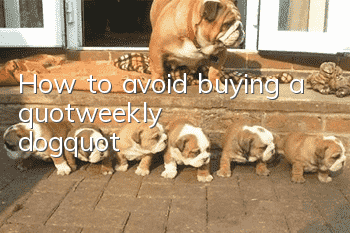How to avoid buying a "weekly dog"?

Many owners who have just started raising dogs have had such unpleasant experiences: they bought a puppy from thousands of choices and spent a lot of money to bring it home. After a few days, the puppy became sick. Fortunately, it went to the hospital and came out. Although there were some sequelae after the fall, he finally managed to save his life. Those who were unlucky... Such dogs usually only have seven days from the time they are bought home to the time they die, so they are vividly called "week dogs". If they can survive a little longer, Those whose time reaches half a month are called "half-moon dogs".
Regardless of whether it is a week-old dog or a half-month-old dog, it was actually infected with a severe infectious disease before it was bought home, but it was still in the incubation period and was not discovered at that time. So how to avoid buying a "week dog"?
Try to avoid cross-infection
The best guarantee when buying a healthy dog is to buy it directly from a breeding farm. The chance of a dog in a breeding farm being infected with a severe infectious disease is basically zero - if a severe infectious disease occurs in a dog farm, it will be a disaster!
The only drawback is that the types of breeding farms are limited, and they are generally located in remote places, making it difficult for ordinary people to find them easily. Therefore, most first-time pet owners choose to choose dogs in the pet market. In the pet market, dogs from all over the world come together for the same goal, which is where dogs without immunity or incomplete immunity are most vulnerable to severe infectious diseases. Familiar with the operating rules of the market is the first condition to avoid buying a Weekly Dog.
The time to select a dog is usually after noon on Saturday, because pet stores generally require breeding farms to transport puppies to the market close to Saturday so that consumers can buy them when they are free on Saturday and Sunday. After noon on Saturday, basically all the dogs had arrived at the "shelf" - of course, in business, time is money. Going to buy a dog at noon on Saturday can not only have the most choices, but also minimize the time the puppy spends in the market, which naturally avoids the infection of serious infectious diseases to the greatest extent.
One thing to mention here is that you should "evacuate" the market as soon as possible after buying a dog. This is to reduce the infection of dogs with severe infectious diseases.
Looking for clues of infectious diseases
Observing the dog’s anus is a common method. Look at the puppy's anus to see if there are any signs of diarrhea.
If there is too much secretion in the dog’s eyes, it means that the dog is at risk of inflammation. Of course, this may not be a sign of a serious infectious disease, or it may just beEyes are inflamed.
You can also check to see if the dog has a runny nose and cough. If so, then your correct approach is to put the puppy down immediately and find a place to wash its hands with soap. Of course, generally speaking, except for rabies, serious infectious diseases in dogs will not be transmitted to humans through such contact. Washing hands is just to avoid bringing germs and viruses to other puppies.
There is one symptom that cannot be concealed by unscrupulous traders. If you feel swollen lymph glands on your dog's lower forehead, it's better to choose another dog to be on the safe side.
When choosing a dog, you don’t necessarily have to stick to purebred dogs or famous dogs, but they must meet one of the most basic conditions - health.
When you first come into contact with a puppy, it walks towards you automatically and confidently, with bright eyes and a wagging tail. You can believe that it is a normal and healthy puppy. On the contrary, if it snorts and hides in the dark when you approach it, it is a puppy with a lonely personality. If you stroke it gently with your hands and it jumps or barks loudly, this is a neurotic puppy born of "inbreeding". It may also have this characteristic when it grows up.
Healthy puppies are lively and energetic, with normal appetite and excretion. Upon closer inspection there are also the following features:
①The eyes are bright, flexible and lively. Use sounds on the left and right sides of the head to determine whether the puppy's hearing is normal.
② The nose is moist, the eyes, ears, and nose are clean and free of secretions, and there is no odor in the ears.
③The color of eye mucosa, oral mucosa and tongue is red but without bloodshot eyes.
④ There should be no baldness, dandruff, ectoparasites (worms) or itching in the fur of the puppy's body, including its limbs and tail.
⑤ Let the puppy stand and touch its whole body. The ribs should be palpable but not clearly visible; the abdomen should not be excessively distended or distended; there should be no lumps in the center of the lower abdomen and groin (to avoid "hernia").
⑥Gently lift the puppy’s tail to make sure the area around the anus and tail are clean.
⑦ By making the dog play, run and jump, the puppy can move normally and flexibly without lameness.
- What should I do if my dog has no milk? The owner should check quickly and don’t let the puppies starve to death.
- Dog’s anal gland odor, please note that this is a sign of your dog’s health!
- How to make your dog like to eat dog food Four ways to make your dog fall in love with dog food
- Can dogs digest peach pits if they eat them? Can dogs digest peach pits if they accidentally eat them?
- How to protect your dog’s food? Teach you tips on training your dog
- Why do dogs defecate everywhere? How can dogs stop defecating everywhere?
- What should I do if my dog has lupus? Immune system diseases should not be underestimated
- If your dog's hair is cut and the skin is cut, the flesh is exposed. If the dog's hair is accidentally cut and the skin is cut, it must be disinfected immediately.
- Do dogs need deworming in summer? What should you pay attention to when raising dogs in summer?
- What to do if your dog has indigestion? Dog indigestion is no small matter!



